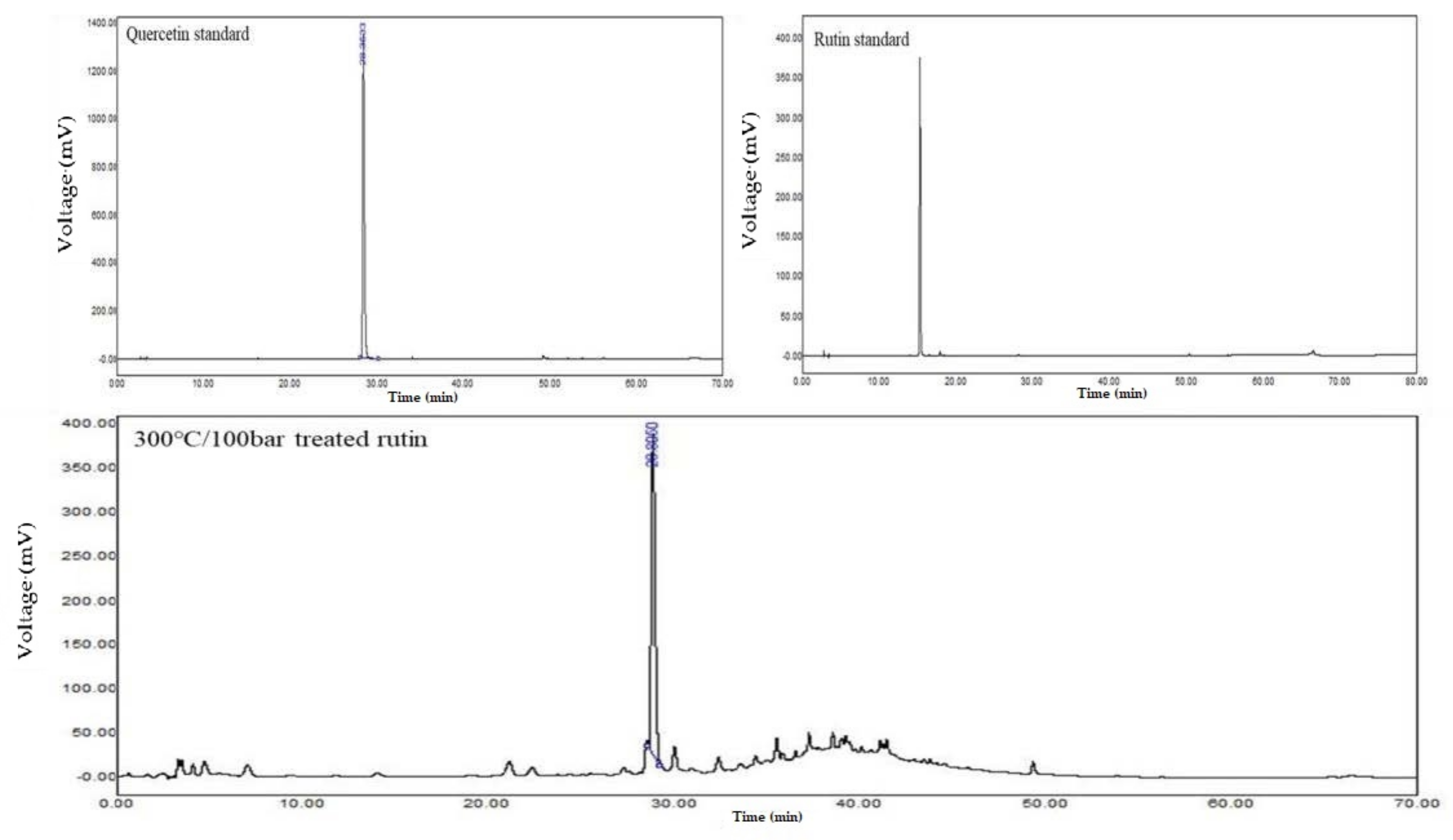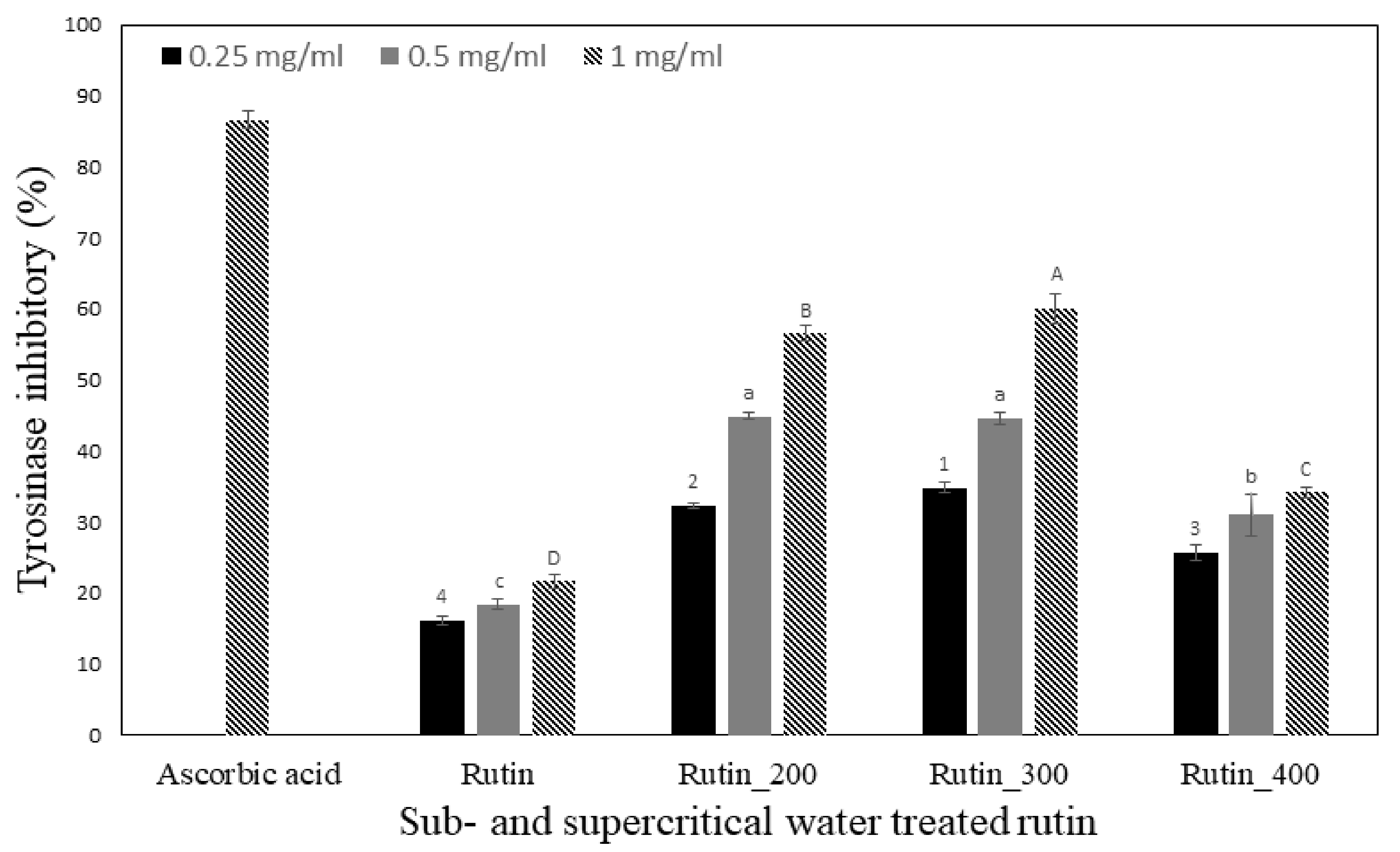Antioxidant and Skin Whitening Activities of Sub- and Super-Critical Water Treated Rutin
Abstract
1. Introduction
2. Results and Discussion
2.1. Rutin and Quercetin Content
2.2. ABTS and DPPH Radical Scavenging Activity
2.3. Reducing Power
2.4. Tyrosinase Inhibitory Activity
2.5. Solvent Fraction
2.6. Cytotoxicity
2.7. Inhibition of Melanin Synthesis
2.8. MITF, TRP-1, TRP-2, and Tyrosinase Protein Expression Rate
3. Materials and Methods
3.1. Materials
3.2. Subcritical and SCW Treatment
3.3. Solvent Fractionation
3.4. Measurement of Rutin and Quercetin Content
3.5. Measurement of ABTS and DPPH Radical Acavenging Activity
3.6. Measurement of Reducing Power
3.7. Measurement of Tyrosinase Inhibitory Activity
3.8. Measurement of Cytotoxicity
3.9. Measurement of Melanin Synthesized on Inhibition
3.10. Measurement of Protein Expression Level Using Western Blot
3.11. Statistical Analysis
4. Conclusions
Author Contributions
Funding
Institutional Review Board Statement
Informed Consent Statement
Data Availability Statement
Conflicts of Interest
Sample Availability
References
- Alargov, D.K.; Deguchi, S.; Tsujii, K.; Horikoshi, K. Reaction behaviors of glycine under super- and subcritical water conditions. Orig. Life Evol. Biosph. 2002, 32, 1–12. [Google Scholar] [CrossRef] [PubMed]
- Lee, M.Y.; Choi, Y.C.; Chun, J.Y.; Min, S.G.; Hong, G.P. Effects of high pressure/high temperature processing on the recovery and characteristics of porcine placenta hydrolysayes. Korean J. Food Sci. An. 2013, 33, 474–480. [Google Scholar] [CrossRef][Green Version]
- Brunner, G. Near critical and supercritical water. Part, I. Hydrolysis and hydrothermal processes. J. Supercrit. Fluid. 2009, 47, 373–381. [Google Scholar] [CrossRef]
- Schmieder, H.; Abeln, J. Supercritical Water Oxidation: State of the Art. Chem. Eng. Technol. 1991, 22, 903–908. [Google Scholar] [CrossRef]
- Suzuki, A.; Oe, T.; Anjo, N.; Suzugaki, H.; Nakamura, T. Commercialization of Supercritical Water Oxidation Destruction of Trichloroethylene, Dimethyl Sulfoxide and Isopropyl Alcohol with Pilot-Scale Process. In Proceedings of the 4th International Symposium on Supercritical Fluids, Sendai, Japan, 11–14 May 1997; pp. 895–899. [Google Scholar]
- Young, M.F. The transpiring wall platelet reactor for supercritical water oxidation of materials with high inorganic loading. In Proceedings of the 4th International Symposium on Supercritical Fluids, Sendai, Japan, 11–14 May 1997; pp. 167–170. [Google Scholar]
- Yang, J.W.; Lee, J.S.; Sung, J.H. Influence of acid treatment on flavonoid content and biological activity in tartary buckwheat grains and its application for noodles. LWT 2021, 145, 111488. [Google Scholar] [CrossRef]
- Bagchi, D.; Sen, C.K.; Bagchi, M.; Atalay, M. Anti-angiogenic, antioxidant, and anti-carcinogenic properties of a novel anthocyanin-richberry extract formula. Biochem. Moscow. 2004, 69, 75–80. [Google Scholar] [CrossRef]
- Ghiasi, M.; Taheri, S.; Tafazzoli, M. Dynamic stereochemistry of rutin (vitamin P) in solution: Theoretical approaches and experimental validation. Carbohydr. Res. 2010, 345, 1760–1766. [Google Scholar] [CrossRef]
- Hong, H.C.; Li, S.L.; Zhang, X.Q.; Ye, W.C.; Zhang, Q.W. Flavonoids with α-glucosidase inhibitory activities and their contents in the leaves of Morus atropurpurea. Chin. Med. 2013, 8, 19. [Google Scholar] [CrossRef]
- Park, S.A.; Park, J.; Park, C.I.; Jie, Y.J.; Hwang, Y.C.; Kim, Y.H.; Jeon, S.H.; Lee, H.M.; Ha, J.H.; Kim, K.J.; et al. Cellular antioxidant activity and whitening effects of Dendropanax morbifera leaf extracts. Korean J. Microbiol. Biotechnol. 2013, 41, 407–415. [Google Scholar] [CrossRef]
- Hwang, C.R.; Oh, S.H.; Kim, H.Y.; Lee, S.H.; Hwang, I.G.; Shin, Y.S.; Lee, J.S.; Jeong, H.S. Chemical Composition and Antioxidant Activity of Deoduk (Codonopsis lanceolata)and Doragi (Platycodon grandiflorum) according to Temperature. J. Korean Soc. Food Sci. Nutr. 2011, 40, 798–803. [Google Scholar] [CrossRef]
- Kim, H.Y.; Woo, K.S.; Hwang, I.G.; Lee, Y.R.; Jeong, H.S. Effects of heat treatments on the antioxidant activities of fruits and vegetables. Korean J. Food Sci. Technol. 2008, 40, 166–170. [Google Scholar]
- Lee, S.H.; Hwang, I.G.; Lee, Y.R.; Joung, E.M.; Jeong, H.S.; Lee, H.B. Physicochemical Characteristics and Antioxidant Activity of Heated Radish (Raphanus sativus L.) Extracts. J. Korean Soc. Food Sci. Nutr. 2009, 38, 490–495. [Google Scholar] [CrossRef]
- Vetrova, E.V.; Maksimenko, E.V.; Khizrieva, S.S.; Bugaeva, A.F.; Borisenko, N.I.; Minkin, V.I. A simple way for the preparation of natural antioxidant quercetin from rutin by subcritical water. J. Nat. Sci. Biol. Med. 2017, 8, 213–215. [Google Scholar]
- Kim, Y.C.; Higuchi, R.; Kitamura, Y.; Komori, T. Thermal degradation of glycosides, IV. Degradation of flavonoid glycosides. Liebigs Ann. Chem. 1991, 12, 1285–1289. [Google Scholar] [CrossRef]
- Manach, C.; Morand, C.; Demigné, C.; Texier, O.; Régérat, F.; Rémésy, C. Bioavailability of rutin and quercetin in rats. FEBS Lett. 1997, 409, 12–16. [Google Scholar] [CrossRef]
- Buchner, N.; Krumbein, A.; Rohn, S.; Kroh, L.W. Effect of thermal processing on the flavonols rutin and quercetin. Rapid Commun. Mass Spectrom. 2006, 20, 3229–3235. [Google Scholar] [CrossRef]
- Jo, E.K.; Heo, D.J.; Kim, J.H.; Lee, Y.H.; Ju, Y.C.; Lee, S.C. The effects of subcritical water treatment on antioxidant activity of golden oyster mushroom. Food Bioprocess Technol. 2013, 6, 2555–2561. [Google Scholar] [CrossRef]
- Meir, S.; Kanner, J.; Akiri, B.; Hadas, S.P. Determination and involvement of aqueous reducing compounds in oxidative defense systems of various senescing leaves. J. Agric. Food Chem. 1995, 43, 1813–1819. [Google Scholar] [CrossRef]
- Kim, J.W.; Nagaoka, T.; Ishida, Y.; Hasegawa, T.; Kitagawa, K.; Lee, S.C. Subcritical water extraction of nutraceutical compounds from citrus pomaces. Sep. Sci. Technol. 2009, 44, 2598–2608. [Google Scholar] [CrossRef]
- Seo, H.K.; Lee, S.C. Antioxidant activity of subcritical water extracts from Chaga mushroom (Inonotus obliquus). Sep. Sci. Technol. 2010, 45, 198–203. [Google Scholar] [CrossRef]
- Cabanes, J.; Chazarra, S.; Garcia-carmona, F. Kojic acid, a cosmetic skin whitening agent, is a slow-binding inhibitor of catecholase activity of tyrosinase. J. Pharm. Pharmacol. 1994, 46, 982–985. [Google Scholar] [CrossRef] [PubMed]
- Koyu, H.; Kazan, A.; Ozturk, T.K.; Yesil-Celiktas, O.; Haznedaroglu, M.Z. Optimizing subcritical water extraction of Morus nigra L. fruits for maximization of tyrosinase inhibitory activity. J. Supercrit. Fluids 2017, 127, 15–22. [Google Scholar] [CrossRef]
- Kang, L.M.; Park, S.A.; Mun, Y.J.; Woo, W.H. Inhibitory Effect of Polyporus umbellatus Extract on Melanogenesis. Korean J. Acupunct. 2020, 37, 24–30. [Google Scholar] [CrossRef]
- Park, J.O.; Park, J.O.; Joo, C.G. A Study on Whitening and Anti-inflammatory Effects of Eriobotrya Japonica Leaf Extracts with Different Extraction Methods. J. Soc. Cosmet. Sci. Korea 2015, 41, 151–157. [Google Scholar]
- Jeon, Y.S.; Jung, Y.J.; Youm, J.K.; Kim, Y.K.; Kim, S.N. Inhibitory Effect of Endarachne binghamiae Extract on Melanin Synthesis. Korean J. Plant Res. 2013, 26, 526–532. [Google Scholar] [CrossRef]
- Kim, B.Y.; Park, S.H.; Park, B.J.; Kim, J.J. Whitening Effect of Androsace Umbellata Extract. J. Soc. Cosmet. Sci. Korea 2015, 41, 21–26. [Google Scholar]
- Anand, P.K.; Somaradhya, M.A.; Soundar, D. Isotation and identification of a radical scavenging antioxidant-punicalagin from pith andcarpellary membrane of pomegranate fruit. Food Chem. 2004, 87, 551–557. [Google Scholar]
- Bouchard, M.; Viau, C. Urinary excretion kinetics of pyrene and benzi(a)pyrene metabolites following intravenous administration of the parent compounds or the metabolites. Toxicol. Appl. Pharmacol. 1996, 139, 301–309. [Google Scholar] [CrossRef]
- Jung, K.H.; Hong, H.D.; Cho, C.W.; Lee, M.Y.; Choi, U.K.; Kim, Y.C. Phenolic acid composition and antioxidative activity of red ginseng prepared by high temperature and high pressure process. Korean J. Food Nutr. 2012, 25, 827–832. [Google Scholar] [CrossRef]
- Seo, M.C.; Ko, J.Y.; Song, S.B.; Lee, J.S.; Kang, J.R.; Kwak, D.Y.; Oh, B.G.; Yoon, Y.N.; Nam, M.H.; Jeong, H.S.; et al. Antioxidant compounds and activities of foxtail millet, 93 proso millet and sorghum with different pulverizing methods. J. Korean Soc. Food Sci. Nutr. 2011, 40, 790–797. [Google Scholar] [CrossRef]
- Choi, Y.; Lee, S.M.; Chun, J.; Lee, H.B.; Lee, J. Influence of heat treatment on the antioxidant activities and polyphenolic compounds of Shiitake (Lentinus edodes) mushroom. Food Chem. 2006, 99, 381–387. [Google Scholar] [CrossRef]
- Hwang, I.G.; Woo, K.; Kim, T.M.; Kim, D.J.; Yang, M.H.; Jeong, H.S. Change of physicochemical characteristics of Korean pear (Pyrus pyrifolia Nakai) juice with heat treatment conditions. Korean J. Food Sci. Technol. 2006, 38, 342–347. [Google Scholar]
- Mau, J.L.; Lin, H.C.; Song, S.F. Antioxidantproperties of several specialty mushrooms. Food Res. Int. 2002, 35, 519–526. [Google Scholar] [CrossRef]
- Yagi, A.; Kanbara, T.; Morinobu, N. The effect of tyrosinase inhibition for aloe. Planta Med. 1987, 3981, 515–517. [Google Scholar] [CrossRef]
- Carmichael, J.; DeGraff, W.G.; Gazdar, A.F.; Minna, J.D.; Mitchell, J.B. Evaluation of a tetrazolium based semiautomated colorimetric assay: Assessment of chemosensitivity testing. Cancer Res. 1987, 47, 936–942. [Google Scholar]
- Hosoi, J.; Abe, E.; Suda, T.; Kuroki, T. Regulation of melanin synthesis of B16 melanoma cell by 1 alpha, 25-dihydroxyvitamin D3 and retinoic acid. Cancer Res. 1985, 45, 1474–1478. [Google Scholar]





| Sample | Rutin (mg/g) | Quercetin (mg/g) | ABTS Radical Scavenging (mg AAE/g) | DPPH Radical Scavenging (mg AAE/g) | Reducing Power |
|---|---|---|---|---|---|
| (Spectrophotometer 700 nm) | |||||
| Rutin | 1000 | N.D. | 465.97 ± 29.73d 4 | 656.08 ± 5.02d | 0.31 ± 0.00d |
| 200 °C 15 bar | N.D. 1 | 381.39 ± 1.52a 2,3 | 787.96 ± 42.13c | 674.39 ± 5.40c | 0.41 ± 0.00c |
| 300 °C 100 bar | N.D. | 218.12 ± 12.41b | 1193.72 ± 6.93a | 728.73 ± 1.34a | 0.65 ± 0.00a |
| 400 °C 250 bar | N.D. | 1.40 ± 0.06c | 945.03 ± 14.58b | 694.88 ± 4.69b | 0.47 ± 0.00b |
| Sample | Rutin (mg/g) | Quercetin (mg/g) | ABTS Radical Scavenging (mg AAE/g) 4 | DPPH Radical Scavenging (mg AAE/g) | Reducing Power |
|---|---|---|---|---|---|
| (700 nm) | |||||
| Hexane | N.D. 1 | 0.80 ± 0.03 c 2,3 | 845.55 ± 2.62 b | 542.17 ± 24.81 c | 0.47 ± 0.00 b |
| Chloroform | N.D. | 20.98 ± 0.30 b | 815.88 ± 27.25 b | 691.13 ± 8.27 b | 0.48 ± 0.02 b |
| Ethyl acetate | N.D. | 248.48 ± 6.63 a | 1358.64 ± 9.07 a | 1410.73 ± 10.04 a | 0.77 ± 0.00 a |
| Butanol | N.D. | N.D. | 161.43 ± 26.87 c | 197.15 ± 9.86 d | 0.14 ± 0.00 c |
| Water | N.D. | N.D. | N.D. | N.D. | N.D. |
Publisher’s Note: MDPI stays neutral with regard to jurisdictional claims in published maps and institutional affiliations. |
© 2022 by the authors. Licensee MDPI, Basel, Switzerland. This article is an open access article distributed under the terms and conditions of the Creative Commons Attribution (CC BY) license (https://creativecommons.org/licenses/by/4.0/).
Share and Cite
Jo, Y.J.; Yoo, D.H.; Lee, I.C.; Lee, J.; Jeong, H.S. Antioxidant and Skin Whitening Activities of Sub- and Super-Critical Water Treated Rutin. Molecules 2022, 27, 5441. https://doi.org/10.3390/molecules27175441
Jo YJ, Yoo DH, Lee IC, Lee J, Jeong HS. Antioxidant and Skin Whitening Activities of Sub- and Super-Critical Water Treated Rutin. Molecules. 2022; 27(17):5441. https://doi.org/10.3390/molecules27175441
Chicago/Turabian StyleJo, Yeon Jae, Dan Hee Yoo, In Chul Lee, Junsoo Lee, and Heon Sang Jeong. 2022. "Antioxidant and Skin Whitening Activities of Sub- and Super-Critical Water Treated Rutin" Molecules 27, no. 17: 5441. https://doi.org/10.3390/molecules27175441
APA StyleJo, Y. J., Yoo, D. H., Lee, I. C., Lee, J., & Jeong, H. S. (2022). Antioxidant and Skin Whitening Activities of Sub- and Super-Critical Water Treated Rutin. Molecules, 27(17), 5441. https://doi.org/10.3390/molecules27175441







